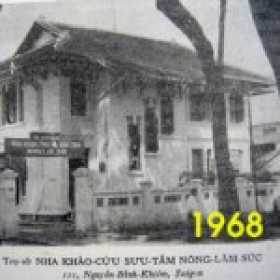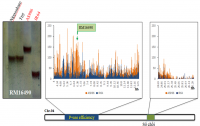|
Truong Tu Anh. 2019. Phenotypic Variation, Genetic Diversity, and Segregation of Vietnamese Rice Mutants. PhD Thesis Abstract. Hiroshima University
Chủ nhật, 14-04-2019 | 06:20:37
|
|
Division of Development Science Hiroshima University
To be recognized as an ideal organism, rice (Oryza sativa L.) has attracted considerable attention not only to food security but also to research targets. More importantly, rice plays an indispensable role in human’s lives by providing a staple food for more than half of the world’s population. Over the past decades, there have been dramatic increases in the global population and in the severe impact of climate change threatening food security. Under these strong influences, rice cultivars need to be improved in yield, quality, and in adaptability. Therefore, numerous studies are focusing on rice improvement to overcome these threats. Extensive and innovative research has been conducted to modify fundamental agronomic traits and to develop elite rice cultivars. Recently, there has been an increasing interest in induced mutation which is considered to be a dominant feature of mutation. Many mutagens cause induced mutation, and chemical mutagen is one of the prominent agents manipulated on rice. N-methyl-N-nitrosourea (MNU), a class of NNitroso compound, is a potent and complete chemical mutagen. MNU is able to alter and damage DNA structure, cause gene mutations, and create high-frequency of mutation. Remarkably, MNU-induced mutant populations are recognized valuable sources for genetic approaches. Reviews of the literature on breeding techniques have indicated that a combination of mutation and innovative methods in biotechnology is most likely to produce a breakthrough in plant breeding. Genetic markers or DNA markers are particular segments of DNA and represent for the differences at the genome level. They are biotechnological innovations which have been applied to rice breeding for well over thirty years. Several prominent DNA markers and their importance have been demonstrated in several studies of genetics. Among DNA markers, SSR marker is one of the effective tools to discover genetic mutation. A considerable amount of literature has been published on SSR marker, and its great advantages have been recognized such as increasing the effectiveness of mutation procedures, discovering the derivation of induced mutants, and classifying important mutations. Studies in the past provided valuable information about MNU-induced mutation in rice and confirmed that mutant populations were crucial genetic sources for functional genomics. However, few suitable MNU mutant populations of rice have recently been developed, and the understanding of the precise effects of MNU agent on the principal agronomic traits and inheritance of rice is still limited. This indicates the absolute necessity to develop rice mutant populations and to evaluate the variations of phenotype and genotype of MNU induced mutants. Therefore, this study sets out to assess both newly developed mutant populations and the effectiveness of the MNU-induced mutation. This study aims to do so with the following objectives: 1. Characterization of phenotypic variations of the MNU-induced mutants; 2. Determination of genetic diversity of the MNU-induced mutants; 3. Evaluation on the segregation of phenotype and genotype of the identified mutant populations over the consecutive years. In this study, four rice mutant populations were cultivated in a field in Higashi-Hiroshima, Hiroshima, Japan to characterize agronomical and morphological traits. Phenotype of mutants and their parents were observed, evaluated, and compared to gather general information and to determine the differences. After characterizing the phenotype, genetic diversity was analysed to detect the variations in genotype of rice mutants. From the results of the identified phenotype and genotype, one prominent population TBR1/KD18 was selected to evaluate the phenotypic and genotypic segregation of each individual in segregating populations (M2 and M3 generations) over two years. Chapter 2 characterizes the phenotypic characters of both rice mutants and their relatives. Characteristics of each population were recorded, analyzed, and compared. The variation and the correlation coefficient values of these phenotypic characters were calculated. The results showed that in a new environmental condition, most of the rice mutants demonstrated their adaptability, particularly in grain yield because mutants possessed higher yield than their respective parents. Full grain was considered as the most relevant factor contributing to grain yield. Amylose content had a relationship with grain length, grain width, and grain length to width ratio. However, the inconsistency correlation and distribution were found not only in all materials but also in each population. Consequently, the resulting phenotypic information and the variations of rice mutants support the idea that MNU has an impact on rice materials and suggest that molecular makers should be applied to genotype these developed mutants. Chapter 3 assesses the genetic diversity of the rice mutants and their parents by identified SSR (Simple Sequence Repeat) markers. Fifty-six polymorphism markers covered across eleven rice chromosomes were determined from eighty-six SSR markers. The average value of alleles of these markers was 3.02 alleles per locus, and the mean value of polymorphism information content was 0.47. By using the unweighted pair group method with arithmetic mean clustering, four clusters were generated with the genetic similarities ranging from 0.52 to 0.91. The genetic variation among groups was 34 %, while the variation among individuals within groups was 66 %. Notably, some mutant lines originated from one cultivar, but they were distinctive genotype as if belonging different clusters and carried the disparate genetic similarities. Remarkably, four clusters had the differences in inheritable types, but only cluster II had the unique inheritance. The cluster II (TBR1/KD18 population) had an unexpected genetic diversity. This cluster included the female parent and its mutant progenies, while the male parent was in cluster I. This finding provides genetic background of the collected rice mutants and supplies the evidence that MNU causes variations in the genotype of rice mutants. The findings detailed in Chapter 2 and Chapter 3 revealed that MNU had a high impact on phenotype and genotype of mutants. Particularly, TBR1/KD18 population revealed distinctive inheritance when analysed by the identified alleles and clustering method, thus it was chosen to evaluate the segregation of phenotype and genotype over two years. Chapter 4 analyses the phenotype and genotype of TBR1 (female parent), KD18 (male parent), M2, and M3 generations (TBR1/KD18’s progenies) which were created by MNU-induced mutation. Two hundred SSR markers were applied to genotype parents and to detect polymorphism markers related to important agronomic traits of rice such as plant height, amylose content, semi-dwarf, protein content, grain yield, spikelet fertility, and disease resistance. Phenotypic evaluation showed that the phenotype of mutants remained significantly different over the two years, while their parents had a slight variation. In genetic analysis, no segregation among the genotypes in the M2 and M3 populations was determined by twenty-eight identified polymorphism markers. Interestingly, all of the mutants in two generations carried only the female’s alleles, and this phenomenon was named maternal inheritance. This finding indicated that it could be possible to control important agronomic traits of rice by MNU-induced mutation which would shorten breeding time because of non-segregation in the genotype of mutants. In conclusion, this study provides further information to support the fact that MNU is one of the strongest mutagens and causes gene mutation in rice. These detailed results confirm the effectiveness of MNU-induced mutation through deviations from phenotype and genotype of mutants. Novel alleles from MNU-induced mutation could be a major factor to improve desired characters of rice. Additionally, maternal inheritance caused by MNU should be considered to improve the desired characters of rice in the shortest time. Further research with more focus on genetic mapping of mutants is suggested to determine the regions related to putative genes that control those traits to draw conclusions about pleiotropy or gene linkage reasoning for genetic variations and maternal inheritance in MNU-induced mutant populations. |
|
|
|
[ Tin tức liên quan ]___________________________________________________
|


 Curently online :
Curently online :
 Total visitors :
Total visitors :
